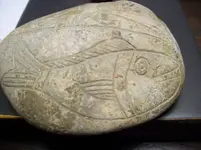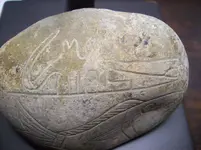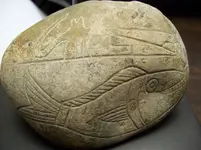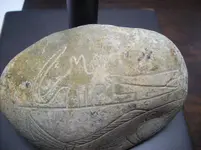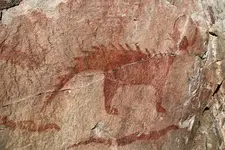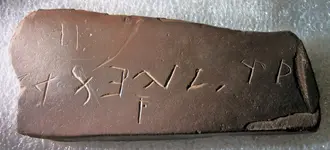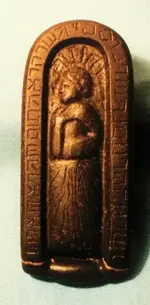Regardless of whether we all disagree or agree on where these people came from they were an anomaly and an unusual race.
Here are a few pictures and a little bit of information I copied on my phone along time ago. Just fascinating. Can't remember the title of the book.
DVD: Searching for the Great Hopewell Road. By American public television is a landmark documentary about one of the most fascinating cultures in ancient North America. It won the Chris award, humanities division, Columbus international video and film Festival.
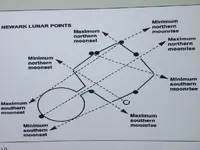
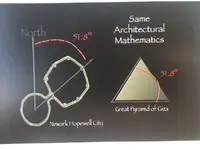
Dr. James P. Scherz, professor of civil engineering at the University of Wisconsin has found astounding new evidence included in the great octagon and great circle structures.
They were built using three units of measurement that were also used in ancient Egypt, the "common foot" or "statue foot", and finally the "Royal foot" (also known as the royal cubit) all of which can be demonstrated to have been used in the making of the structures. If the interior of the octagon a squared, the square that is formed has a base to dimension of 606 feet, which is the same length as the "stade" of ancient Egypt. The angle of the Great Pyramid of Egypt from the base up to the slope to the tip is 51.8° degrees, which happens to be the precise angle of the great octagon complex when passing a line through its main axis and then measuring to true north. Did the Hopewell have interaction with the Egyptians, or were they familiar with their measuring systems?
The octagon earthworks are aligned to the points on the horizon that mark the limits of the rising and setting of the moon throughout an 18.6 year long cycle. The main axis of the octagon earthworks is aligned to the moons northernmost rising.
Professors Ray Hively and Robert Horn of Earlham college, Richmond, Indiana, estimate that the odds that the octagons alignments are purely accidental are about one in 40 million. Some fairly sophisticated people I would say.
Monks mound is the largest prehistoric earthen construction in the New World. It measures 1037 feet long and 775 feet wide at its base and rises in three levels too high of 100 feet. This makes monks mound slightly larger at its base than the great pyramid of Giza. It's base circumference is larger than the Pyramid of the Sun at Teotihuacan.
Unlike Egyptian and Mayan pyramids which were built of stone, monks mound was constructed almost entirely of layers of basket transported soil and Clay. It is estimated that over 14 million baskets full of soil roughly 22,000,000 ft.³ by volume was used in its construction. Atop the colossal earthen structure was found evidence for a very large rectangular wooden building offset to the rear of the highest platform. It is thought that this structure was a temple.
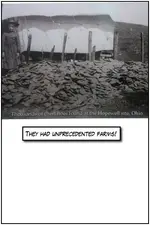
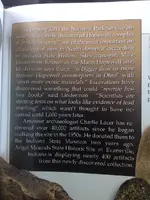


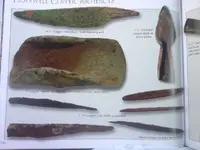
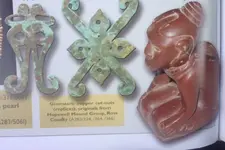

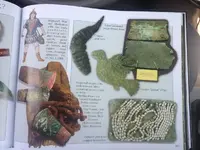

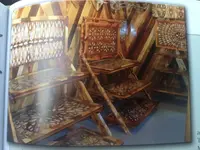
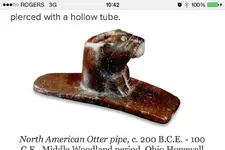
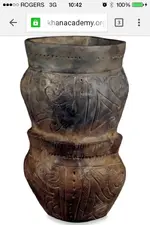
The Adena complex, in the middle and upper Ohio valley, is the most significant evidence
Zoned Pottery Vessel, c. 200 B.C.E. - 100 C.E., Middle Woodland period, Ohio Hopewell culture, 25 cm high, Mound City, Ohio, North America [emoji767] Trustees of the British Museum
of an Early Woodlands society in the last millennium B.C.E. The economy was based on hunting and fishing, and from 100 B.C.E. apparently also on the growing of squash, pumpkin, sunflowers, goosefoot and marsh elder. Burial mounds were constructed in several stages, with log-lined pits containing burials with fine grave goods, including smoking pipes. Mounds were constructed within large earthworks that were probably built for ceremonial and economic purposes, rather than as defensive strongpoints.
One or two double pots of this type have been recovered from mound sites. They are decorated with figures which represent aquatic and/or raptorial birds, suggesting the ancient Woodlands dichotomy between creatures of the upper and lower worlds.
Excavations in mounds in Ohio have uncovered superbly carved pipes and other exotic trade goods and fine artworks. The pipes may have been smoked for purification during rituals, and to ensure the good standing of the particular form of native government, whether clan, lineage, or larger grouping.
This tobacco pipe was made by the Hopewell people, and is in the shape of an otter's head. Otters were an important religious animal to the Hopewell, because they were equally at home on both land and in water. The tobacco was placed in a hole in the top of the otter's head, and the smoke breathed in through the flat base which is pierced with a hollow tube.
North American Otter pipe, c. 200 B.C.E. - 100 C.E., Middle Woodland period, Ohio Hopewell culture, stone, 10 x 5.1 x 3.3 cm, Mound City, Ohio, North America [emoji767] Trustees of the British Museum. Excavated in 1846. This is one of the approximately 200 pipes found in Mound 8, most of these pipes being animal effigies, and many of those being animals that either fly, or as is the case with this pipe, swim. The deep carved empty eye sockets would have originally had fresh water pearls, and it is thought that originally there was a fish in the mouth of this otter.
A number of pipes in the form of aquatic mammals were found at Mound City. They were to become important in perhaps the most significant archaeological debate of the mid-nineteenth century: were the mounds built by people related to the present-day Native population? If not, who built them?
The "Moundbuilder Myth"
Most American antiquarians thought that the scale and magnificence of the earthworks indicated that they had been erected by an unrelated people, the "Moundbuilders," whom the Native Indian replaced. To support their theory, they claimed that the otter pipes represented vegetarian manatees, living 1000 miles away in the seas around tropical Florida. The "Moundbuilder Myth" eased nineteenth-century guilt at the rapidly disappearing Indian population. Just as the Indians had replaced the Moundbuilders - perhaps coming from the Old World—so Americans, it was thought, would entirely replace Indians.
New DNA evidence suggest a link in North America. A fifth sounding genetic haplogroup was found among Native Americans to have ties to Europe rather than Asia.
The five markers that delineate this group have been found throughout Europe and are known to be one of the 12 primary Jewish haplogroup lineages. The lineage is called Haplogroup X. And its origins are according to geneticist the "hills of Galilee" of the holy land of Israel.
It has been found in many Israelite populations. Ancient new world populations have now also been DNA sequenced with rather incredible new findings. Haplogroup X was subsequently found among the Algonquian speaking language groups of the North America which included over 100 and Native American tribes.
Controversial, sure. However nobody can reject the books which of been written by prominent archaeologist and other scholars who attest that the Hopewell Indians are a highly civilized culture.
Interesting conversations though. [emoji6]
